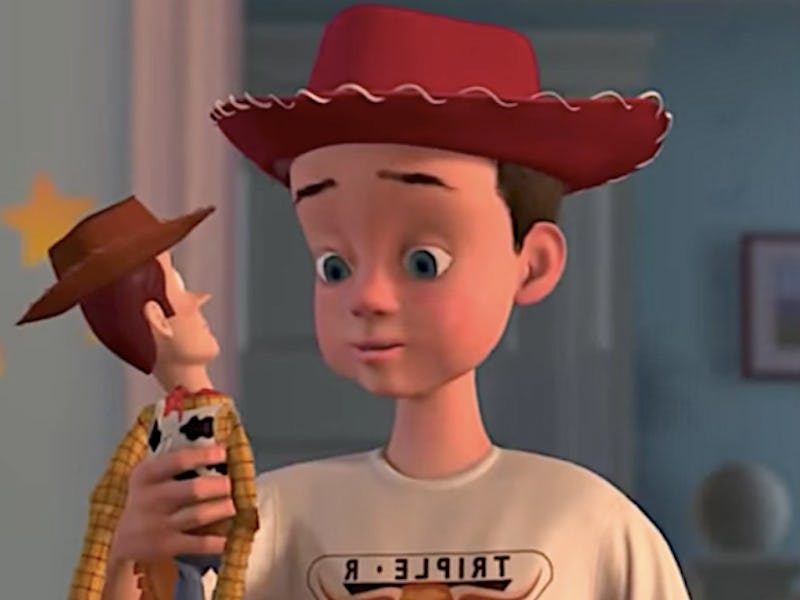'Toy Story' Polio Theory Reveals Why Woody Almost Got Torched

Anyone who grew up with Toy Story wondered, at one point or another, where Andy’s dad was. It was easiest to assume that Andy’s dad had died or left after a divorce, but a controversial though highly plausible theory that began circulating in this month posits that he died because of polio — and that Woody, who originally belonged to him, was almost destroyed as a result. Toy Story’s creators have squashed the rumor, but they can’t deny that from a medical perspective, the devastating narrative is completely believable.
The rumor started when former Toy Story consultant Mike Mozart described the polio backstory in an online interview on June 22, where he explained how the devastating disease haunted Andy’s family for years. Andy’s dad, also named Andy, had polio as a child, which is when he first etched his name onto the boot of Woody, a one-of-a-kind figurine. In the so-called Toy Story 0 timeline, Andy Sr. recovered from his illness, but most of his toys were doomed to the incinerator because they were covered in polio virus. Andy Sr. rescued Woody, together with the old-school favorites Slinky Dog and Mr. Potato Head, by shoving them in a chest. Then, Andy Sr. died from “post-polio syndrome,” and the toys remained dormant until Andy Jr. opened up that chest with his father’s key.
While Pixar writer and director Andrew Stanton told The Hollywood Reporter on Saturday that the whole story was “fake news,” the polio-related scenarios that Mozart’s story posited are entirely plausible, if not probable.
Toy-burning to curtail the spread of disease was a brutal but practical public health strategy, especially in the days before anti-bacterial wipes and obsessive hand-washing. Polio, a paralysis-causing disease caused by the poliomyelitis virus, is spread through the oral-fecal route — that is, when virus in poop gets into another body via the mouth — and can indeed be transferred when people touch objects contaminated with polio-harboring feces and then put their hands in their mouth.
Had Andy Sr. really been infected with polio as a child, it’s likely he would have had to go through the traumatic experience of watching his toys get burned to a crisp (a situation that horrified fans actually confronted in Toy Story 3). He wouldn’t have been the first kid to be devastated by the experience; in the Velveteen Rabbit, the titular bunny is blamed for giving its child-owner scarlet fever (“Why, it’s a mass of scarlet fever germs!” a doctor declares) and is also sentenced to burn. In this case, the Streptococcus-ridden Rabbit is rescued not by its owner but by a fairy, which turns it into a real animal.
It might seem that Andy Sr. might not have been doing his future son any favors by stowing away a bunch of polio-laced toys, but fortunately the virus doesn’t live very long without a host. According to the World Health Organization, none of the three wild poliovirus strains can survive for very long outside the human body. However, the United States Centers for Disease Control and Prevention points out that polio can survive “in an infected person’s stool for many weeks.” So, the stashed-away toys would have posed more of a threat to Andy Sr.’s parents as they rifled through their son’s belongings, especially if they carried traces of fecal matter. However, at some point in their middle age, they would have received the revolutionary polio vaccine, which led to the world’s near-eradication of the disease. By 1989, when Andy Jr. was born, it would have been over a decade since the U.S. saw its last case of polio., and compulsory school vaccinations would have ensured his safety.
Unfortunately, post-polio syndrome, which takes Andy Sr.’s life in this sad alternate history, is also a very real thing. It’s a cluster of polio-like symptoms such as increasing muscle weakness, joint pain, and fatigue that affects people who have recovered from polio, though how it actually causes disabilities still isn’t well understood. It’s not usually life-threatening, but it can be severely debilitating, causing some people to lose the ability to swallow, which in turn could lead to complications such as pneumonia.
Toy Story is already pretty somber as far as Disney franchises go, so it’s probably for the best that Stanton is denying Mozart’s claim. But even if it is true, it wouldn’t be the first kids’ story that’s been sugarcoated to cover up the harsh realities of the disease-ridden real world.